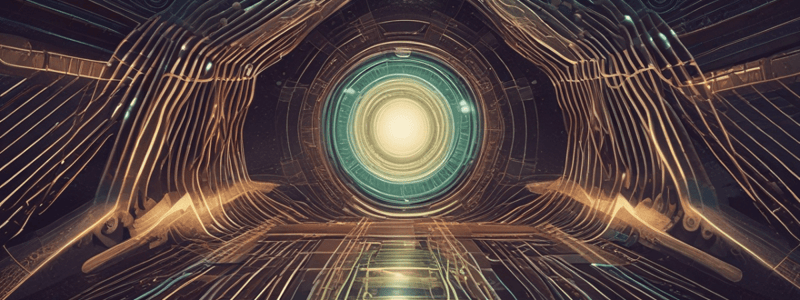Podcast
Questions and Answers
How does light interact with objects when shone on them?
How does light interact with objects when shone on them?
- It changes the object's color
- It gets absorbed by the object
- It passes through the object
- It bounces off the object (correct)
What is unique about the behavior of photons?
What is unique about the behavior of photons?
- They act as neither particles nor waves
- They act as both particles and waves (correct)
- They only act as waves
- They only act as particles
What determines the type of electromagnetic radiation?
What determines the type of electromagnetic radiation?
- The frequency and wavelength of the light (correct)
- The direction and distance of the light
- The intensity and speed of the light
- The color and brightness of the light
What is the relationship between frequency and wavelength of light?
What is the relationship between frequency and wavelength of light?
What type of light has a higher amount of energy?
What type of light has a higher amount of energy?
What is the main difference between absorption and reflection of light?
What is the main difference between absorption and reflection of light?
Why do black cars get hotter than light-colored cars?
Why do black cars get hotter than light-colored cars?
What is an example of light transmission?
What is an example of light transmission?
What is true about waves in general?
What is true about waves in general?
What happens to the light that is not absorbed by an object?
What happens to the light that is not absorbed by an object?
What is the definition of the transmission of waves?
What is the definition of the transmission of waves?
What happens to light when it is transmitted through a material?
What happens to light when it is transmitted through a material?
Why does the sky appear blue to us?
Why does the sky appear blue to us?
What is an example of refraction of light in nature?
What is an example of refraction of light in nature?
What is the purpose of using sunglasses with colored lenses?
What is the purpose of using sunglasses with colored lenses?
Study Notes
Light Transmission
- Light is made up of individual units called photons, which act as both particles and waves.
- The electromagnetic radiation spectrum includes different forms of light, such as:
- Microwaves, radio waves, and visible light (middle of the spectrum)
- Ultraviolet light, x-rays, and gamma rays (high frequencies, high energy)
- Infrared light, microwaves, and radio waves (low frequencies, low energy)
- When light interacts with objects, it can be:
- Reflected (bounced off, like a particle)
- Absorbed (energy taken in by molecules, transformed into thermal energy)
- Transmitted (passes through objects, like a wave)
Light Absorption and Reflection
- Objects with high reflective properties (e.g., glass, mirrors, shiny surfaces) reflect most of the light that hits them.
- Opaque objects absorb light, converting it to thermal energy.
- Light absorption and reflection are responsible for our perception of color:
- White light (all frequencies) hits an object, and the reflected color is what we see.
Light Transmission Examples
- Light transmission through transparent materials (e.g., glass, water, plastic) allows light to pass through with little change.
- In the atmosphere, about 30% of sunlight is reflected, while the rest is absorbed or transmitted to the Earth's surface.
- Scattering and refraction occur when light interacts with the atmosphere:
- Scattering: light hits atoms and is transmitted in all directions (making the sky appear blue)
- Refraction: light bends as it changes speed through a material (creating rainbows)
Transmission of Waves Definition
- Waves are disturbances in a medium that travel through the medium in an organized way.
- Waves can propagate energy, momentum, and/or information, but not matter.
- Types of waves include:
- Light waves (photons, particles of light)
- Sound waves (require a medium, like air or water)
- Kinetic waves (transfer energy through a medium, like water)
Wave Transmission
- Wave transmission is the movement of a wave through a medium.
- The type of wave and medium can change the wave's energy, wavelength, and frequency.
- Energy loss occurs when waves change medium or type.
- Waves can be scattered or refracted as they transmit through a medium.
Studying That Suits You
Use AI to generate personalized quizzes and flashcards to suit your learning preferences.
Description
Explore how light travels and interacts with objects around us, including how it affects the color of objects and our ability to see.





